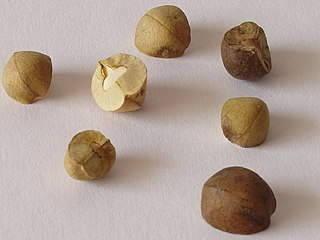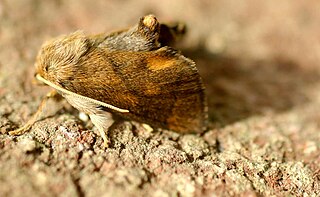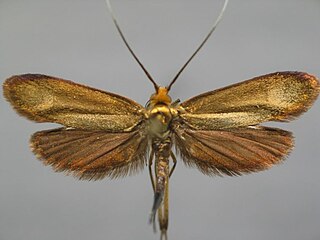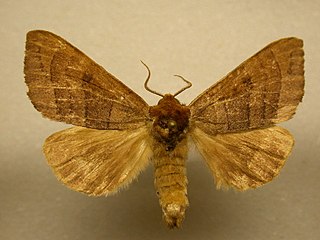
Mexican jumping beans are seed pods that have been inhabited by the larva of a small moth and are native to Mexico. The pod is usually tan to brown. They are from the shrub Sebastiania pavoniana, often also referred to as "jumping bean". However, they are not related to actual beans, but rather to spurges. The beans are considered non-toxic but are not generally eaten. In the spring, when the shrub is flowering, moths lay their eggs on the shrub's hanging seedpods. When the eggs hatch, tiny larvae bore into the immature green pods and begin to devour the seeds. The pods ripen, fall to the ground and separate into three smaller segments, and those segments are called Mexican jumping beans. As the tiny larvae inside curl up and uncurl, they hit the capsule's wall with their heads – and the bean jumps. They move more as temperatures rise, the larva eats away the inside of the bean and attaches itself to the inside of the bean with silk-like thread.

The blotched emerald is a moth of the family Geometridae. The species was first described by Michael Denis and Ignaz Schiffermüller in 1775. It is found throughout Europe and the Near East. It has a scattered distribution in England and Wales, but is absent from Scotland and Ireland. In the southern Alps it rises up to 1000 metres.It is mainly found in oak forests.

Laothoe populi, the poplar hawk-moth, is a moth of the family Sphingidae. The species was first described by Carl Linnaeus in his 1758 10th edition of Systema Naturae. It is found throughout the Palearctic region and the Near East and is one of the most common members of the family in the region. It is distinctive due to its habit of resting with its hindwings held further forward than the forewings.

Notodontidae is a family of moths with approximately 3,800 known species. The family was described by James Francis Stephens in 1829. Moths of this family are found in all parts of the world, but they are most concentrated in tropical areas, especially in the New World.

The Limacodidae or Eucleidae are a family of moths in the superfamily Zygaenoidea or the Cossoidea; the placement is in dispute. They are often called slug moths because their caterpillars bear a distinct resemblance to slugs. They are also called cup moths because of the shape of their cocoons.

The dryandra moth is a species of moth that is considered to be the sole member of the family Carthaeidae. Its closest relatives are the Saturniidae and it bears a resemblance to many species of that family, bearing prominent eyespots on all wings. The common name is derived from the Dryandra shrubs of the genus Banksia, on which the larva of this species feed, and is hence restricted to the south-west of Western Australia where these shrubs grow. Other Grevillea shrubs may also be used as host plants.

Nemophora metallica is a moth of the family Adelidae. It is found in Europe.

Datana contracta, the contracted datana, is a species of moth in the family Notodontidae. It is found from Maine to Florida and west to Arkansas and Wisconsin.

Datana is a genus of moths of the family Notodontidae. The genus was erected by Francis Walker in 1855.

Datana major, the major datana or azalea caterpillar, is a moth of the family Notodontidae. It is found from Maryland to Florida, west to Kansas and Arkansas.

Datana perspicua, the spotted datana, is a species of prominent moth in the family Notodontidae. It was described by Augustus Radcliffe Grote and Coleman Townsend Robinson in 1865 and is found in North America.

Datana drexelii, or Drexel's datana, is a species of prominent moth in the family Notodontidae. It is found in North America.
Datana ranaeceps, the post-burn datana, is a species of moth in the family Notodontidae. Other common names include the heart-leaved catchfly and ranaeceps datana moth. It was first described by Félix Édouard Guérin-Méneville in 1844 and it is found in North America.

Datana angusii, or Angus's datana moth, is a species of moth in the family Notodontidae. It was first described by Augustus Radcliffe Grote and Coleman Townsend Robinson in 1866 and it is found in North America.
Datana robusta, the annual buttonweed or robust datana moth, is a species of moth in the family Notodontidae. It was first described by Herman Strecker in 1878 and it is found in North America.
Datana chiriquensis is a species of moth in the family Notodontidae. It was first described by Harrison Gray Dyar Jr. in 1895 and it is found in North America.
Datana diffidens is a species of moth in the family Notodontidae. It was first described by Harrison Gray Dyar Jr. in 1917 and it is found in North America.
Datana neomexicana is a species of moth in the family Notodontidae. It was first described by Doll in 1911 and it is found in North America.


















